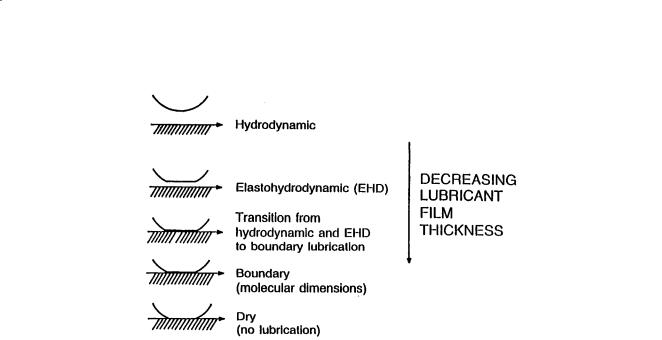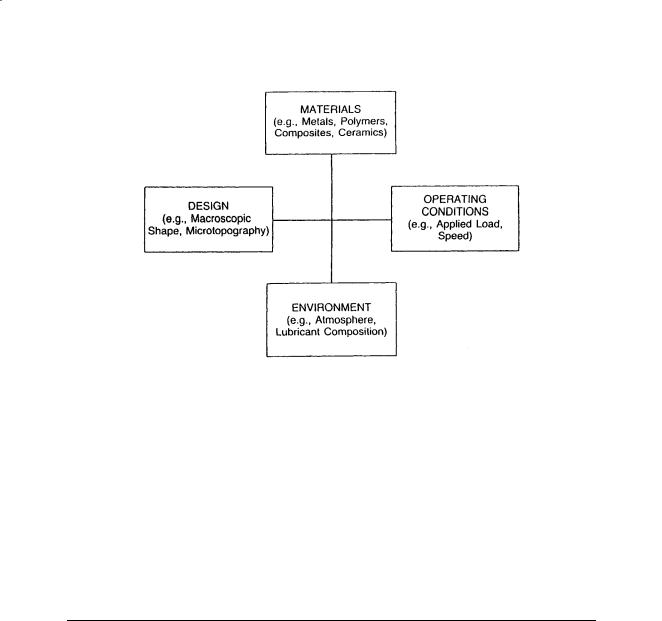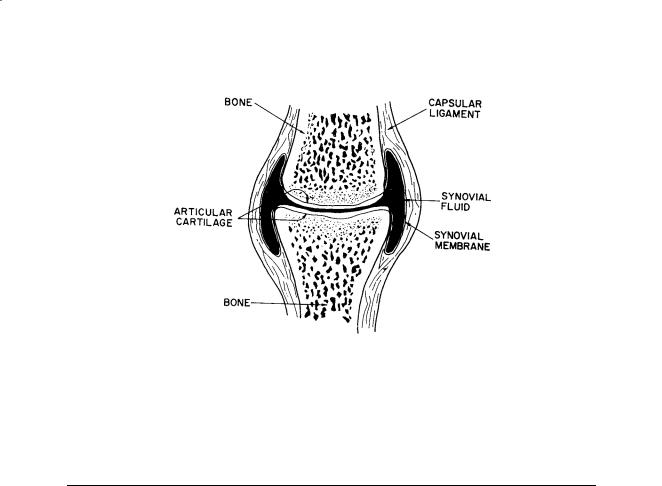
Biomechanics Principles and Applications - Schneck and Bronzino
.pdf

Michael J. Furey
Mechanical Engineering Department and Center for Biomedical Engineering, Virginia Polytechnic Institute and State University
4
Joint Lubrication
4.1 |
Introduction.......................................................................... |
73 |
4.2 |
Tribology ............................................................................... |
74 |
|
Friction • Wear and Surface Damage |
|
4.3 |
Lubrication............................................................................ |
75 |
|
Hydrodynamic Lubrication Theories • |
Transition from |
|
Hydrodynamic to Boundary Lubrication |
|
4.4 |
Synovial Joints ...................................................................... |
79 |
4.5Theories on the Lubrication of Natural and Normal
|
Synovial Joints ...................................................................... |
80 |
4.6 |
In Vitro Cartilage Wear Studies ........................................... |
83 |
4.7 |
Biotribology and Arthritis: Are There Connections?............ |
87 |
4.8 |
Recapitulation and Final Comments .................................. |
89 |
|
Terms and Definitions • Experimental Contact Systems • |
|
|
Fluids and Materials Used as Lubricants in in Vivo Studies |
• |
|
The Preoccupation with Rheology and Friction • The |
|
|
Probable Existence of Various Lubrication Regimes • Recent |
|
|
Developments |
|
4.9 |
Conclusions........................................................................... |
93 |
The Fabric of the Joints in the Human Body is a subject so much the more entertaining, as it must strike every one that considers it attentively with an Idea of fine Mechanical Composition. Wherever the Motion of one Bone upon another is requisite, there we find an excellent Apparatus for rendering that Motion safe and free: We see, for Instance, the Extremity of one Bone molded into an orbicular Cavity, to receive the Head of another, in order to afford it an extensive Play. Both are covered with a smooth elastic Crust, to prevent mutual Abrasion; connected with strong Ligaments, to prevent Dislocation; and inclosed in a Bag that contains a proper Fluid Deposited there, for lubricating the Two contiguous Surfaces. So much in general.
The above is the opening paragraph of the surgeon Sir William Hunter’s classic paper “Of the Structure and Diseases of Articulating Cartilages,” which he read to a meeting of the Royal Society, June 2, 1743 [1]. Since then, a great deal of research has been carried out on the subject of synovial joint lubrication. However, the mechanisms involved are still unknown.
4.1 Introduction
The purpose of this chapter is twofold: (1) to introduce the reader to the subject of tribology—the study of friction, wear, and lubrication; and (2) to extend this to the topic of biotribology, which includes the lubrication of natural synovial joints. It is not meant to be an exhaustive review of joint lubrication theories; space does not permit this. Instead, major concepts or principles will be discussed not only in
0-8493-1492-5/03/$0.00+$.50 © 2003 by CRC Press LLC

74 |
Biomechanics: Principles and Applications |
the light of what is known about synovial joint lubrication but perhaps more importantly what is not known. Several references are given for those who wish to learn more about the topic. It is clear that synovial joints are by far the most complex and sophisticated tribological systems that exist. We shall see that although numerous theories have been put forth to attempt to explain joint lubrication, the mechanisms involved are still far from being understood. And when one begins to examine possible connections between tribology and degenerative joint disease or osteoarthritis, the picture is even more complex and controversial. Finally, this article does not treat the (1) tribological behavior of artificial joints or partial joint replacements, (2) the possible use of elastic or poroplastic materials as artificial cartilage, and (3) new developments in cartilage repair using transplanted chondrocytes. These are separate topics, which would require detailed discussion and additional space.
4.2 Tribology
The word tribology, derived from the Greek “to rub,” covers all frictional processes between solid bodies moving relative to one another that are in contact [2]. Thus tribology may be defined as the study of friction, wear, and lubrication.
Tribological processes are involved whenever one solid slides or rolls against another, as in bearings, cams, gears, piston rings and cylinders, machining and metalworking, grinding, rock drilling, sliding electrical contacts, frictional welding, brakes, the striking of a match, music from a cello, articulation of human synovial joints (e.g., hip joints), machinery, and in numerous less obvious processes (e.g., walking, holding, stopping, writing, and the use of fasteners such as nails, screws, and bolts).
Tribology is a multidisciplinary subject involving at least the areas of materials science, solid and surface mechanics, surface science and chemistry, rheology, engineering, mathematics, and even biology and biochemistry. Although tribology is still an emerging science, interest in the phenomena of friction, wear, and lubrication is an ancient one. Unlike thermodynamics, there are no generally accepted laws in tribology. But there are some important basic principles needed to understand any study of lubrication and wear and even more so in a study of biotribology or biological lubrication phenomena. These basic principles follow.
Friction
Much of the early work in tribology was in the area of friction—possibly because frictional effects are more readily demonstrated and measured. Generally, early theories of friction dealt with dry or unlubricated systems. The problem was often treated strictly from a mechanical viewpoint, with little or no regard for the environment, surface films, or chemistry.
In the first place, friction may be defined as the tangential resistance that is offered to the sliding of one solid body over another. Friction is the result of many factors and cannot be treated as something as singular as density or even viscosity. Postulated sources of friction have included (1) the lifting of one asperity over another (increase in potential energy), (2) the interlocking of asperities followed by shear,
(3) interlocking followed by plastic deformation or plowing, (4) adhesion followed by shear, (5) elastic hysteresis and waves of deformation, (6) adhesion or interlocking followed by tensile failure,
(7) intermolecular attraction, (8) electrostatic effects, and (9) viscous drag. The coefficient of friction, indicated in the literature by or f, is defined as the ratio F/W where F = friction force and W = the normal load. It is emphasized that friction is a force and not a property of a solid material or lubricant.
Wear and Surface Damage
One definition of wear in a tribological sense is that it is the progressive loss of substance from the operating surface of a body as a result of relative motion at the surface. In comparison with friction, very little theoretical work has been done on the extremely important area of wear and surface damage. This is not too surprising in view of the complexity of wear and how little is known of the mechanisms by which it can occur. Variations in wear can be, and often are, enormous compared with variations in friction. For example,

Joint Lubrication |
75 |
practically all the coefficients of sliding friction for diverse dry or lubricated systems fall within a relatively narrow range of 0.1 to 1. In some cases (e.g., certain regimes of hydrodynamic or “boundary” lubrication), the coefficient of friction may be <0.1 and as low as 0.001. In other cases (e.g., very clean unlubricated metals in vacuum), friction coefficients may exceed one. Reduction of friction by a factor of two through changes in design, materials, or lubricant would be a reasonable, although not always attainable, goal. On the other hand, it is not uncommon for wear rates to vary by a factor of 100, 1000, or even more.
For systems consisting of common materials (e.g., metals, polymers, ceramics), there are at least four main mechanisms by which wear and surface damage can occur between solids in relative motion:
(1) abrasive wear, (2) adhesive wear, (3) fatigue wear, and (4) chemical or corrosive wear. A fifth, fretting wear and fretting corrosion, combines elements of more than one mechanism. For complex biological materials such as articular cartilage, most likely other mechanisms are involved.
Again, wear is the removal of material. The idea that friction causes wear and therefore, low friction means low wear, is a common mistake. Brief descriptions of five types of wear; abrasive, adhesive, fatigue, chemical or corrosive, and fretting—may be found in Furey [2] as well as in other references in this chapter. Next, it may be useful to consider some of the major concepts of lubrication.
4.3 Lubrication
Lubrication is a process of reducing friction and/or wear (or other forms of surface damage) between relatively moving surfaces by the application of a solid, liquid, or gaseous substance (i.e., a lubricant). Since friction and wear do not necessarily correlate with each other, the use of the word and in place of and/or in the above definition is a common mistake to be avoided. The primary function of a lubricant is to reduce friction or wear or both between moving surfaces in contact with each other.
Examples of lubricants are wide and varied. They include automotive engine oils, wheel bearing greases, transmission fluids, electrical contact lubricants, rolling oils, cutting fluids, preservative oils, gear oils, jet fuels, instrument oils, turbine oils, textile lubricants, machine oils, jet engine lubricants, air, water, molten glass, liquid metals, oxide films, talcum powder, graphite, molybdenum disulfide, waxes, soaps, polymers, and the synovial fluid in human joints.
A few general principles of lubrication may be mentioned here.
1.The lubricant must be present at the place where it can function.
2.Almost any substance under carefully selected or special conditions can be shown to reduce friction or wear in a particular test, but that does not mean these substances are lubricants.
3.Friction and wear do not necessarily go together. This is an extremely important principle which applies to nonlubricated (dry) as well as lubricated systems. It is particularly true under conditions of “boundary lubrication,” to be discussed later. An additive may reduce friction and increase wear, reduce wear and increase friction, reduce both, or increase both. Although the reasons are not fully understood, this is an experimental observation. Thus, friction and wear should be thought of as separate phenomena—an important point when we discuss theories of synovial joint lubrication.
4.The effective or active lubricating film in a particular system may or may not consist of the original or bulk lubricant phase.
In a broad sense, it may be considered that the main function of a lubricant is to keep the surfaces apart so that interaction (e.g., adhesion, plowing, and shear) between the solids cannot occur; thus, friction and wear can be reduced or controlled.
The following regimes or types of lubrication may be considered in the order of increasing severity or decreasing lubricant film thickness (Fig. 4.1):
1.Hydrodynamic lubrication
2.Elastohydrodynamic lubrication
3.Transition from hydrodynamic and elastohydrodynamic lubrication to boundary lubrication
4.Boundary lubrication

76 |
Biomechanics: Principles and Applications |
FIGURE 4.1 Regimes of lubrication.
A fifth regime, sometimes referred to as dry or unlubricated, may also be considered as an extreme or limit. In addition, there is another form of lubrication that does not require relative movement of the bodies either parallel or perpendicular to the surface, i.e., as in externally pressurized hydrostatic or aerostatic bearings.
Hydrodynamic Lubrication Theories
In hydrodynamic lubrication, the load is supported by the pressure developed due to relative motion and the geometry of the system. In the regime of hydrodynamic or fluid film lubrication, there is no contact between the solids. The film thickness is governed by the bulk physical properties of the lubricants, the most important being viscosity; friction arises purely from shearing of viscous lubricant.
Contributions to our knowledge of hydrodynamic lubrication, with special focus on journal bearings, have been made by numerous investigators including Reynolds. The classic Reynolds treatment considered the equilibrium of a fluid element and the pressure and shear forces on this element. In this treatment, eight assumptions were made (e.g., surface curvature is large compared to lubricant film thickness, fluid is Newtonian, flow is laminar, viscosity is constant through film thickness). Velocity distributions due to relative motion and pressure buildup were developed and added together. The solution of the basic Reynolds equation for a particular bearing configuration results in a pressure distribution throughout the film as a function of viscosity, film shape, and velocity.
The total load W and frictional (viscous) drag F can be calculated from this information. For rotating disks with parallel axes, the “simple” Reynolds equation yields:
h |
|
ηU |
|
|
o |
= 4.9 |
|
|
(4.1) |
|
|
|||
R |
|
W |
|
|
where ho is the minimum lubricant film thickness, η is the absolute viscosity, U is the average velocity (U1 + U2)/2, W is the applied normal load per unit width of disk, and R is the reduced radius of curvature
(1/R = 1/R1 + 1/R2).
The dimensionless term (ηU/W) is sometimes referred to as the hydrodynamic factor. It can be seen that doubling either the viscosity or velocity doubles the film thickness, and that doubling the applied load halves the film thickness. This regime of lubrication is sometimes referred to as the rigid isoviscous

Joint Lubrication |
77 |
or classical Martin condition, since the solid bodies are assumed to be perfectly rigid (non-deformable), and the fluid is assumed to have a constant viscosity.
At high loads with systems such as gears, ball bearings, and other high-contact-stress geometries, two additional factors have been considered in further developments of the hydrodynamic theory of lubrication. One of these is that the surfaces deform elastically; this leads to a localized change in geometry more favorable to lubrication. The second is that the lubricant becomes more viscous under the high pressure existing in the contact zone, according to relationships such as:
η ηo = exp α (p − po ) |
(4.2) |
where η is the viscosity at pressure p, ηo is the viscosity at atmospheric pressure po, and α is the pressureviscosity coefficient (e.g., in Pa–1). In this concept, the lubricant pressures existing in the contact zone approximate those of dry contact Hertzian stress. This is the regime of elastohydrodynamic lubrication, sometimes abbreviated as EHL or EHD. It may also be described as the elastic-viscous type or mode of lubrication, since elastic deformation exists and the fluid viscosity is considerably greater due to the pressure effect.
The comparable Dowson–Higginson expression for minimum film thickness between cylinders or disks in contact with parallel axes is:
h |
|
ηU 0.7 |
αW 0.54 |
W |
0.03 |
|||
o |
= 2.6 |
|
|
|
|
|
|
|
R |
|
|
||||||
|
W |
|
R |
|
RE′ |
|||
The term E′ represents the reduced modulus of elasticity:
1 |
= |
(1− ν12 ) |
+ |
(1− |
ν22 ) |
|
E′ |
E |
E |
2 |
|||
|
|
|||||
|
|
1 |
|
|
(4.3)
(4.4)
where E is the modulus, ν is Poisson’s ratio, and the subscripts 1 and 2 refer to the two solids in contact. All the other terms are the same as previously stated. In addition to the hydrodynamic factor (ηU/W), a pressure-viscosity factor (αW/R) and an elastic deformation factor (W/RE′) can be considered. Thus, properties of both the lubricant and the solids as materials are included. In examining the elastohydrodynamic film thickness equations, it can be seen that the velocity U is an important factor (ho U 0.7) but the load W is rather unimportant (ho W–0.13).
Experimental confirmation of the elastohydrodynamic lubrication theory has been obtained in certain selected systems using electrical capacitance, x-ray transmission, and optical interference techniques to determine film thickness and shape under dynamic conditions. Research is continuing in this area, including studies on micro-EHL or asperity lubrication mechanisms, since surfaces are never perfectly smooth. These studies may lead to a better understanding of not only lubricant film formation in high- contact-stress systems but lubricant film failure as well.
Two other possible types of hydrodynamic lubrication, rigid-viscous and elastic-isoviscous, complete the matrix of four, considering the two factors of elastic deformation and pressure-viscosity effects. In addition, squeeze film lubrication can occur when surfaces approach one another. For more information on hydrodynamic and elastohydrodynamic lubrication, see Cameron [3] and Dowson and Higginson [4].
Transition from Hydrodynamic to Boundary Lubrication
Although prevention of contact is probably the most important function of a lubricant, there is still much to be learned about the transition from hydrodynamic and elastohydrodynamic lubrication to

78 |
Biomechanics: Principles and Applications |
boundary lubrication. This is the region in which lubrication goes from the desirable hydrodynamic condition of no contact to the less acceptable “boundary” condition, where increased contact usually leads to higher friction and wear. This regime is sometimes referred to as a condition of mixed lubrication.
Several examples of experimental approaches to thin-film lubrication have been reported [3]. It is important in examining these techniques to make the distinction between methods that are used to determine lubricant film thickness under hydrodynamic or elastohydrodynamic conditions (e.g., optical interference, electrical capacitance, or x-ray transmission), and methods that are used to determine the occurrence or frequency of contact. As we will see later, most experimental studies of synovial joint lubrication have focused on friction measurements, using the information to determine the lubrication regime involved; this approach can be misleading.
Boundary Lubrication
Although there is no generally accepted definition of boundary lubrication, it is often described as a condition of lubrication in which the friction and wear between two surfaces in relative motion are determined by the surface properties of the solids and the chemical nature of the lubricant rather than its viscosity. An example of the difficulty in defining boundary lubrication can be seen if the term bulk viscosity is used in place of viscosity in the preceding sentence—another frequent form. This opens the door to the inclusion of elastohydrodynamic effects which depend in part on the influence of pressure on viscosity. Increased friction under these circumstances could be attributed to increased viscous drag rather than solid-solid contact. According to another common definition, boundary lubrication occurs or exists when the surfaces of the bearing solids are separated by films of molecular thickness. That may be true, but it ignores the possibility that “boundary” layer surface films may indeed be very thick (i.e., 10, 20, or 100 molecular layers). The difficulty is that boundary lubrication is complex.
Although a considerable amount of research has been done on this topic, an understanding of the basic mechanisms and processes involved is by no means complete. Therefore, definitions of boundary lubrication tend to be nonoperational. This is an extremely important regime of lubrication because it involves more extensive solid–solid contact and interaction as well as generally greater friction, wear, and surface damage. In many practical systems, the occurrence of the boundary lubrication regime is unavoidable or at least quite common. The condition can be brought about by high loads, low relative sliding speeds (including zero for stop-and-go, motion reversal, or reciprocating elements), and low lubricant viscosity—factors that are important in the transition from hydrodynamic to boundary lubrication.
The most important factor in boundary lubrication is the chemistry of the tribological system—the contacting solids and total environment including lubricants. More particularly, the surface chemistry and interactions occurring with and on the solid surfaces are important. This includes factors such as physisorption, chemisorption, intermolecular forces, surface chemical reactions, and the nature, structure, and properties of thin films on solid surfaces. It also includes many other effects brought on by the process of moving one solid over another, such as: (1) changes in topography and the area of contact,
(2) high surface temperatures, (3) the generation of fresh reactive metal surfaces by the removal of oxide and other layers, (4) catalysis, (5) the generation of electrical charges, and (6) the emission of charged particles such as electrons.
In examining the action of boundary lubricant compounds in reducing friction or wear or both between solids in sliding contact, it may be helpful to consider at least the following five modes of film formation on or protection of surfaces: (1) physisorption, (2) chemisorption, (3) chemical reactions with the solid surface, (4) chemical reactions on the solid surface, and (5) mere interposition of a solid or other material. These modes of surface protection are discussed in more detail in Furey [2].
The beneficial and harmful effects of minor changes in chemistry of the environment (e.g., the lubricant) are often enormous in comparison with hydrodynamic and elastohydrodynamic effects. Thus, the surface and chemical properties of the solid materials used in tribological applications become especially important. One might expect that this would also be the case in biological (e.g., human joint) lubrication where biochemistry is very likely an important factor.

Joint Lubrication |
79 |
FIGURE 4.2 In any tribological system, friction, wear, and surface damage depend on four interrelated factors.
General Comments on Tribological Processes
It is important to recognize that friction and wear depend upon four major factors, i.e., materials, design, operating conditions, and total environment (Fig. 4.2). This four-block figure may be useful as a guide in thinking about synovial joint lubrication either from a theoretical or experimental viewpoint—the topic discussed in the next section.
Readers are cautioned against the use of various terms in tribology which are either vaguely defined or not defined at all. These would include such terms as “lubricating ability,” “lubricity,” and even “boundary lubrication.” For example, do “boundary lubricating properties” refer to effects on friction or effects on wear and damage? It makes a difference. It is emphasized once again that friction and wear are different phenomena. Low friction does not necessarily mean low wear. We will see several examples of this common error in the discussion of joint lubrication research.
4.4 Synovial Joints
Examples of natural synovial or movable joints include the human hip, knee, elbow, ankle, finger, and shoulder. A simplified representation of a synovial joint is shown in Fig. 4.3. The bones are covered by a thin layer of articular cartilage bathed in synovial fluid confined by synovial membrane. Synovial joints are truly remarkable systems—providing the basis of movement by allowing bones to articulate on one another with minimal friction and wear. Unfortunately, various joint diseases occur even among the young—causing pain, loss of freedom of movement, or instability.
Synovial joints are complex, sophisticated systems not yet fully understood. The loads are surprisingly high and the relative motion is complex. Articular cartilage has the deceptive appearance of simplicity and uniformity. But it is an extremely complex material with unusual properties. Basically, it consists of water (approximately 75%) enmeshed in a network of collagen fibers and proteoglycans with high molecular weight. In a way, cartilage could be considered as one of Nature’s composite materials. Articular cartilage also has no blood supply, no nerves, and very few cells (chondrocytes).
The other major component of an articular joint is synovial fluid, named by Paracelsus after “synovia” (egg-white). It is essentially a dialysate of blood plasma with added hyaluronic acid. Synovial fluid contains complex proteins, polysaccharides, and other compounds. Its chief constituent is water (approximately 85%). Synovial fluid functions as a joint lubricant, nutrient for cartilage, and carrier for waste products.

80 |
Biomechanics: Principles and Applications |
FIGURE 4.3 Representation of a synovial joint.
For more information on the biochemistry, structure, and properties of articular cartilage, Freeman [5], Sokoloff [6], Stockwell [7] and articles referenced in these works are suggested.
4.5Theories on the Lubrication of Natural and Normal Synovial Joints
As stated, the word tribology means the study of friction, wear, and lubrication. Therefore, biotribology may be thought of as the study of biological lubrication processes, e.g., as in synovial joints. A surprisingly large number of concepts and theories of synovial joint lubrication have been proposed [8–10] (as shown in Table 4.1). And even if similar ideas are grouped together, there are still well over a dozen fundamentally different theories. These have included a wide range of lubrication concepts, e.g., hydrodynamic, hydrostatic, elasto-hydrodynamic, squeeze-film, “boundary,” mixed-regime, “weeping,” osmotic, synovial mucin gel, “boosted,” lipid, electrostatic, porous layers, and special forms of boundary lubrication (e.g., “lubricating glycoproteins,” structuring of boundary water “surface-active” phospholipids). This chapter will not review these numerous theories, but excellent reviews on the lubrication of synovial joints have been written by McCutchen [11], Swanson [12], and Higginsworth and Unsworth [13]. The book edited by Dumbleton is also recommended [14]. In addition, theses by Droogendijk [15] and Burkhardt [16] contain extensive and detailed reviews of theories of joint lubrication.
McCutchen was the first to propose an entirely new concept of lubrication, “weeping lubrication”, applied to synovial joint action [17,18]. He considered unique and special properties of cartilage and how this could affect flow and lubrication. The work of Mow et al. continued along a more complex and sophisticated approach in which a biomechanical model is proposed for the study of the dynamic interaction between synovial fluid and articular cartilage [19,20]. These ideas are combined in the more recent work of Ateshian [21] which uses a framework of the biphasic theory of articular cartilage to model interstitial fluid pressurization. Several additional studies have also been made of effects of porosity and compliance, including the behavior of elastic layers, in producing hydrodynamic and squeeze-film lubrication. A good review in this area was given by Unsworth who discussed both human and artificial joints [22].
The following general observations are offered on the theories of synovial joint lubrication that have been proposed:

Joint Lubrication |
81 |
1.Most of the theories are strictly mechanical or rheological—involving such factors as deformation, pressure, and fluid flow.
2.There is a preoccupation with friction, which of course is very low for articular cartilage systems.
3.None of the theories considers wear—which is neither the same as friction nor related to it.
4.The detailed structure, biochemistry, complexity, and living nature of the total articular cartilage– synovial fluid system are generally ignored.
These are only general impressions. And although mechanical/rheological concepts seem dominant (with a focus on friction), wear and biochemistry are not completely ignored. For example, Simon [23] abraded articular cartilage from human patellae and canine femoral heads with a stainless steel rotary file, measuring the depth of penetration with time and the amount of wear debris generated. Cartilage wear was also studied experimentally by Bloebaum and Wilson [24], Radin and Paul [25], and Lipshitz, Etheredge, and Glimcher [26–28]. The latter researchers carried out several in vitro studies of wear of articular cartilage using bovine cartilage plugs or specimens in sliding contact against stainless steel plates. They developed a means of measuring cartilage wear by determining the hydroxyproline content of both the lubricant and solid wear debris. Using this system and technique, effects of variables such as time, applied load, and chemical modification of articular cartilage on wear and profile changes were determined. This work is of particular importance in that they addressed the question of cartilage wear and damage rather than friction, recognizing that wear and friction are different phenomena.
Special note is also made of two researchers, Swann and Sokoloff, who considered biochemistry as an important factor in synovial joint lubrication. Swann et al. very carefully isolated fractions of bovine synovial fluid using sequential sedimentation techniques and gel permeation chromatography. They found a high molecular weight glycoprotein to be the major constituent in the articular lubrication fraction from bovine synovial fluid and called this LGP-I (from lubricating glycoprotein). This was based on friction measurements using cartilage in sliding contact against a glass disc. An excellent summary of this work with additional references is presented in a chapter by Swann in The Joints and Synovial Fluid: I [6].
Sokoloff et al. examined the “boundary lubricating ability” of several synovial fluids using a latex-glass test system and cartilage specimens obtained at necropsy from knees [29]. Measurements were made of friction. The research was extended to other in vitro friction tests using cartilage obtained from the nasal septum of cows and widely differing artificial surfaces [30]. As a result of this work, a new model of boundary lubrication by synovial fluid was proposed—the structuring of boundary water. The postulate involves adsorption of one part of a glycoprotein on a surface followed by the formation of hydration shells around the polar portions of the adsorbed glycoprotein; the net result is a thin layer of viscous “structured” water at the surface. This work is of particular interest in that it involves not only a specific and more detailed mechanism of boundary lubrication in synovial joints but also takes into account the possible importance of water in this system.
In more recent research by Jay, an interaction between hyaluronic acid and a “purified synovial lubricating factor” (PSLF) was observed, suggesting a possible synergistic action in the boundary lubrication of synovial joints [31]. The definition of “lubricating ability” was based on friction measurements made with a latex-covered stainless steel stud in oscillating contact against polished glass.
The above summary of major synovial joint lubrication theories is taken from Furey and Burkhardt [10] and Jay [31], as well as the thesis by Burkhardt [33].
Two more recent studies are of interest since cartilage wear was considered although not as a part of a theory of joint lubrication. Stachowiak et al. [34] investigated the friction and wear characteristics of adult rat femur cartilage against a stainless steel plate using an environmental scanning microscope (ESM) to examine damaged cartilage. One finding was evidence of a load limit to lubrication of cartilage, beyond which high friction and damage occurred. Another study, by Hayes et al. [35] on the influence of crystals on cartilage wear, is particularly interesting not only in the findings reported (e.g., certain crystals can increase cartilage wear), but also in the full description of the biochemical techniques used.
